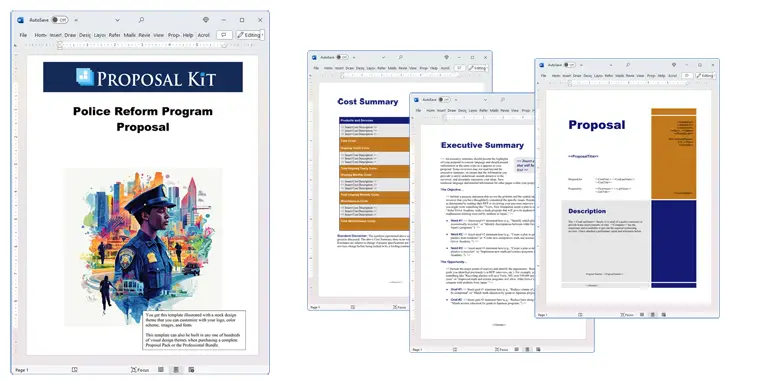How to write your Police Reform Program Proposal
We include this 26 page layout with every Proposal Pack. If you want this template to have a different visual design theme than the one illustrated here, purchase any Proposal Pack design and create this template using the purchased design theme. This template is included in every Proposal Pack. If you get a Proposal Pack or the Professional, you can also make any variation of this template with different chapters to suit your needs.
We typically include more chapters in the templates than most people will need to give everyone more variety in the chapters they may need. You can trim down a long template by removing pages you do not need or combining multiple chapter topics into one page.
 DOWNLOADABLE, ONE-TIME COST, NO SUBSCRIPTION FEES
DOWNLOADABLE, ONE-TIME COST, NO SUBSCRIPTION FEESYou can also create countless variations of this document to suit your needs using the included library of 2200+ chapters if ordering a Proposal Pack or Professional.
 What Our Clients Say
What Our Clients SayI recently purchased Proposal Pack Vending #2. It’s amazing. I really love it. Thank you so much!"
Related Article
Related Video
Related Templates
- Police Reform and Reallocation Proposal
- Community Action Report to Fight Police Abuse
- Interagency Training Center Proposal
- Safety Plan
- Security Plan
- Security Training and Consulting Services Proposal
- Safety Training and Consulting Services Proposal
- Security Tactical Training Proposal
- Security and Risk Analysis Project
- Security Survey, Analysis and Standard Compliance Proposal
- Safety Strategy and Training Program Proposal
- Political Action Proposal
- Crisis Resolution Training Proposal
- Gun Control Legislation Proposal
- Fighting Discrimination Funding Proposal
What's the best way to write your police reform program proposal?
A proven solution for creating an effective police reform program proposal is using the Proposal Kit template and software package. This system simplifies proposal writing by allowing the creation of custom templates, which seamlessly integrate a line item quoting database for comprehensive cost summaries, quotes, estimates, budgets, and other financial details critical for your project.
Are you faced with writing a proposal for a community security initiative or police reform and training program? If so, the Proposal Kit is your solution.
What Types of Projects Are Police Reform Program Proposals Written For?
Police reform program proposals are crucial for many projects aimed at improving community safety and enhancing the effectiveness of law enforcement agencies. Here are examples of such projects:
- Development of community policing strategies
- Implementation of new training programs for police officers
- Upgrading police technological resources
- Establishing oversight and accountability mechanisms
- Creating partnerships with community organizations
- Reforming police use-of-force policies
- Enhancing transparency in police operations
- Building early intervention systems for officers
- Developing anti-discrimination training programs
- Implementing body-worn camera programs
- Designing youth engagement programs
- Setting up mental health response teams
- Reforming drug enforcement strategies
- Enhancing conflict resolution training
- Creating programs for officer wellness and resilience
- Developing data-driven policing strategies
- Implementing restorative justice initiatives
- Training on legal and ethical standards
- Enhancing internal audit and inspection processes
- Launching public relations campaigns to rebuild trust
Chapters this template is built with
No one-size-fits-all premade template will cover all situations. However, Proposal Kit's software and template packages allow you to create a custom proposal using its extensive chapter template library and software. Here are examples of some chapters you could use in this type of proposal:
Cover Letter
A personalized cover letter introduces your organization and understanding of the problem, setting the stage for a detailed discussion on the following pages. For a police reform program proposal, the cover letter should briefly touch on your organization's experience with similar initiatives and express your commitment to community safety and effective law enforcement.
Executive Summary
The Executive Summary provides a brief overview of the proposal, highlighting the key benefits and outcomes of the proposed police reform program. It should summarize the primary issues, the proposed solutions, goals, and anticipated impacts on the police force and the community.
Justification
The Justification section explains the reasons behind the need for reform, supported by data and case studies to strengthen the argument. It may include statistics on crime rates, instances of police misconduct, community surveys, and comparisons to best practices in other jurisdictions.
Challenges
Discuss the specific Challenges the current police system faces, which the proposal aims to address, providing a realistic view of existing problems. This could involve issues like lack of public trust, outdated training practices, limited resources, or high use-of-force incidents.
Goals and Objectives
Outline the main Goals and Objectives of the reform program, detailing the expected improvements and benchmarks for success. Goals include reducing incidents of excessive force, improving community relations, and increasing officer accountability, with specific, measurable objectives connected to these goals.
Implementation
The Implementation section delineates the step-by-step plan to achieve the outlined goals, including timelines and responsible parties. This could involve detailed schedules for training sessions, Procurement of new technology, phases of community outreach, and more.
Procurement
Details on Procurement explain how necessary resources and services (like new technology or consultancy) will be acquired. For a police reform program, this might include purchasing body cameras, hiring external consultants for training, and developing new software for data management.
Training
The Training section outlines the programs for officers and administrative staff, including schedules, content, and trainers. Training topics include de-escalation techniques, anti-bias education, mental health response, and legal updates.
Outreach
Discuss Outreach initiatives to engage with the community and gain their support and input throughout the reform process. This could involve town hall meetings, surveys, and partnerships with community organizations to ensure the reform efforts are inclusive and clear.
Risk Management
Risk Management identifies potential risks in the program implementation and proposes mitigation strategies. For example, a risk might be resistance from within the police force, which could be mitigated through internal communications and workshops to explain the benefits of the reforms.
Background
Provide a Background with context about the current state of policing, previous reforms, and the societal landscape influencing the need for change. This section might include historical data, previous reform efforts, and societal changes that necessitate new approaches to policing.
Time Line
The Timeline clarifies the project phases, ensuring all stakeholders understand the key milestones and deadlines. It should specify when each stage of the reform will occur, such as training, implementation of new policies, and community outreach.
Security
The Security section details the measures that will be implemented to ensure the safety of data and personnel involved in the reform process. This might include cybersecurity measures for data protection and physical security plans for training and public meetings.
Framework
Outline the Framework of governance and structure that will support the implementation of the reform initiatives. This could include the formation of oversight committees, reporting structures, and lines of accountability.
Visibility
Discuss how the reform efforts will be made Visible to the public and how transparency will be maintained. Methods include regular public reports, a dedicated website for the reform initiative, and social media updates.
Results
Describe the expected Results and how they will be measured against the set objectives. Metrics include reduced complaints against officers, improved community survey scores, and lower crime rates.
Monitoring
Monitoring mechanisms to oversee the progress and effectiveness of the reform program are crucial for adaptive management. This might involve regular audits, surveys, and feedback sessions with police officers and community members.
Budget
The Budget section provides a detailed financial plan, covering all expected costs and funding sources. This should include costs for training, new equipment, personnel, and any contingency funds required.
Response
Outline the community's and internal stakeholders' expected responses regarding the reform program. This might involve anticipated support or opposition and strategies to address these reactions constructively.
Partnerships
Detail Partnerships that will be important for enhancing the program's reach and effectiveness. Potential partners include local government agencies, non-profits, educational institutions, and community groups.
Personnel
The Personnel section details the staffing needs, including any new hires or reassignments within the police department. It should outline the qualifications required for these roles and their specific responsibilities in the reform process.
Exit Strategy
Discuss the exit strategy to ensure the program can end or transition smoothly into ongoing operations once objectives are met. This might include plans for handing off responsibilities to permanent staff, continued funding sources, and long-term monitoring.
Sustainability
Sustainability plans are essential to ensure the long-term impact of the reforms implemented. These plans could involve ongoing training programs, continuous community engagement, and mechanisms for regular policy review and revision.
Use cases for this template
Streamlining Community Policing Initiatives
The Challenge
John from SecureFutures Ltd. faced a considerable challenge while attempting to propose a comprehensive community policing initiative. The primary issue was persuasively and feasibly addressing the community's safety and engagement needs. The existing policing strategy was outdated, and significant community distrust toward law enforcement existed. John needed to create a proposal that not only provided new policing strategies but also rebuilt community trust and fostered cooperation.
The Solution
Realizing the task's complexity, John turned to the Proposal Kit template to structure his proposal. This tool helped him ensure that every topic related to the community's needs and the requisite police training programs were comprehensively covered. The Proposal Kit provided pre-designed templates that included sections for community engagement, officer training, technology upgrades, and public safety measures. This organization made it easier for John to compile and present his ideas coherently.
The Implementation
By adhering to the guidance provided by the Proposal Kit, John was able to develop a detailed implementation timeline and budget. He outlined each initiative phase, from initial community consultations to the final roll-out of new policing strategies. He also included a detailed budget that covered training programs, new equipment, and community outreach events. This thorough planning and clear documentation ensured all stakeholders understood the proposal's scope and practicality.
The Outcome
The proposal was well-received by both the community and law enforcement authorities - the clear and detailed presentation of the proposed strategies and their implementation built trust among the stakeholders. As a result, John's initiative improved police-community relations, enhanced safety protocols, and a more collaborative approach to community policing. The positive reception of the proposal paved the way for SecureFutures Ltd. to secure funding and support for the initiative.
Enhancing Officer Training Programs
The Challenge
Emily at Reform Dynamics Inc. was under pressure to prepare a proposal for an internal officer training program. The company had identified gaps in its training processes affecting officer performance and accountability. With a short deadline, Emily needed to develop a comprehensive proposal that addressed these issues and could be implemented immediately.
The Solution
Given the time constraints, Emily used the Proposal Kit software to streamline her proposal writing process. The Proposal Kit allowed her to efficiently outline the training objectives, methods, and resources needed for the program. The pre-designed templates in the software provided sections detailing the curriculum, trainer qualifications, training schedules, and evaluation methods. This structure helped Emily focus on content quality rather than formatting and organization.
The Implementation
Using the Proposal Kit templates, Emily met her tight deadline with clear and professional documentation. She structured the proposal to include detailed descriptions of the training modules, timelines for implementation, and metrics for measuring the program's success. The clear organization and thoroughness of the proposal made it easy for decision-makers to understand the necessity and benefits of the training program.
The Outcome
The proposal was approved in record time, allowing Reform Dynamics Inc. to implement the training program immediately. The new training modules led to better-prepared, more accountable, and effective officers. The training program's success also enhanced the company's reputation for innovative and effective law enforcement training solutions.
Developing Oversight Mechanisms
The Challenge
Mark, the director at Accountability Now, was tasked with writing an RFP for external consultants to develop oversight mechanisms for a police department. The goal was to create robust oversight mechanisms to increase department transparency and accountability. However, creating a detailed and comprehensive RFP that clearly defined the scope and expectations for consultancy services was challenging.
The Solution
Mark chose the Proposal Kit template to ensure clarity and comprehensiveness in his RFP. The template provided a structured format with all necessary sections, including project scope, deliverables, timelines, budget, and evaluation criteria. This structured approach helped Mark clearly articulate the requirements and expectations for the oversight mechanisms.
The Implementation
With the help of the Proposal Kit, Mark could clearly define the scope of work and expectations for the consultancy services. He outlined the specific areas that needed oversight, increased transparency goals, and the consultants' expected deliverables. The detailed and structured RFP made it easier for potential consultants to understand the project's requirements and submit relevant proposals.
The Outcome
The streamlined RFP process attracted several qualified consultants, each offering innovative solutions for the oversight mechanisms. Ultimately, Accountability Now chose a consultant with a proven track record in developing effective oversight systems. The new oversight mechanisms were successfully implemented, leading to increased accountability and transparency within the police department. This success further established Accountability Now's reputation as a leader in police reform initiatives.
Conclusions and Recommendations
Proposal Kit provides the essential templates and tools to articulate your vision persuasively. From outlining complex financial plans to structuring detailed implementation strategies, Proposal Kit equips you with the necessary resources to address the multifaceted topics of police reform programs, ensuring your proposals are complete and compelling.
Also Known As
This template may also be referred to in different ways or be used in more specialized situations, such as:
- Law Enforcement Reform Proposal
- Police Training Initiative Proposal
- Community Policing Strategy Pitch
- Police Accountability Project Proposal
- Public Safety Enhancement Plan
- Officer Training Program Outline
- Police Department Reform Strategy
- Law Enforcement Transparency Proposal
- Community Safety Improvement Plan
- Policing Strategy Reform Document
Abstract
 Law enforcement agencies across the United States are seeking comprehensive criminal justice reform to address pressing challenges such as officer-involved shootings and systemic racism. These reforms aim to enhance police-community relations and reduce incidents of police violence and brutality. Law enforcement leaders are committed to implementing measures such as mandatory mental health counseling and implicit bias awareness training to promote officer safety and improve public safety.
Law enforcement agencies across the United States are seeking comprehensive criminal justice reform to address pressing challenges such as officer-involved shootings and systemic racism. These reforms aim to enhance police-community relations and reduce incidents of police violence and brutality. Law enforcement leaders are committed to implementing measures such as mandatory mental health counseling and implicit bias awareness training to promote officer safety and improve public safety.
Key proposals include reallocating police funding to support training officers in de-escalation techniques, developing new police policies, and building partnerships with community organizations. These strategies are designed to address racial disparities and strengthen procedural justice within the criminal justice system. Police chiefs across the nation are advocating for clear police union contracts, enhanced oversight through civilian payouts and liability insurance, and the use of a national decertification index to track problem officers.
To facilitate these reforms, Proposal Kit offers a robust software package that simplifies the creation of comprehensive reform program proposals. Users can create detailed implementation plans for initiatives such as mental health response teams and data-driven policing strategies, using extensive template libraries for tailored proposals. This tool aids in developing frameworks for effective oversight, measuring the impact of reforms, and ensuring accountability in police culture. By fostering collaboration and informed leadership, the Proposal Kit helps agencies meet specific community needs and drive meaningful social justice reforms across America.
 The landscape of police reform is undergoing significant transformation as law enforcement leaders across the nation grapple with public outcry over police brutality and officer-involved shootings. In response, a national movement is underway to implement comprehensive reforms that address systemic inequities and promote community trust. These efforts are bolstered by the involvement of state law enforcement agencies and police personnel dedicated to reducing violent crime through innovative strategies.
The landscape of police reform is undergoing significant transformation as law enforcement leaders across the nation grapple with public outcry over police brutality and officer-involved shootings. In response, a national movement is underway to implement comprehensive reforms that address systemic inequities and promote community trust. These efforts are bolstered by the involvement of state law enforcement agencies and police personnel dedicated to reducing violent crime through innovative strategies.
The Proposal Kit serves as an important resource for developing thorough reform proposals that address the multifaceted challenges facing police agencies today. By enabling the creation of detailed documents, the Proposal Kit assists users in outlining de-escalation training, normalizing mental health counseling for officers, and creating policies that limit the use of lethal force. This tool is invaluable for city officials and police chiefs striving to adhere to national standards and secure federal funding for their initiatives.
At the core of these reforms is an emphasis on strengthening police-community relations and fostering transparency through civilian oversight. Proposals often incorporate strategies such as co-responder models for mental health crises and the examination of disciplinary records to ensure accountability for individual officers. Meanwhile, working groups and national associations are pushing for legislative changes that address qualified immunity and enhance crime prevention tactics.
 Research shows that such reforms can lead to significant crime reduction and improve the well-being of both officers and residents. By using insights from political and social science, these reform efforts aim to dismantle structural racism and create a more equitable criminal justice system. The Proposal Kit facilitates this mission by providing tools for comprehensive analysis and the presentation of policy recommendations that are informed by evidence and best practices from other agencies.
Research shows that such reforms can lead to significant crime reduction and improve the well-being of both officers and residents. By using insights from political and social science, these reform efforts aim to dismantle structural racism and create a more equitable criminal justice system. The Proposal Kit facilitates this mission by providing tools for comprehensive analysis and the presentation of policy recommendations that are informed by evidence and best practices from other agencies.
In tackling these complex issues, reform advocates recognize the importance of public comment and community involvement. By including voices from diverse neighborhoods and considering the perspectives of black Americans and other marginalized groups, reform proposals can address the specific needs of the communities they serve. The Proposal Kit s robust framework supports these endeavors by ensuring that all topics of reform, from training to public relations, are thoughtfully planned and executed.
Ultimately, these reform initiatives seek to uphold fairness and legitimacy in policing, responding to the calls for change that have resonated across America in the wake of high-profile incidents involving George Floyd and Breonna Taylor. Through the efficient use of resources provided by Proposal Kit, stakeholders can work towards a final plan that redefines the relationship between law enforcement officers and the communities they protect, paving the way for a safer and more just society.
 The urgency for police reform is underscored by recent events involving officer-involved shootings and the pressing need to strengthen police-community relations. With many officers seeking to improve their interactions with the public, comprehensive reforms are being implemented to reduce such incidents. These efforts are particularly crucial in addressing domestic violence cases and improving responses to mental illness within communities.
The urgency for police reform is underscored by recent events involving officer-involved shootings and the pressing need to strengthen police-community relations. With many officers seeking to improve their interactions with the public, comprehensive reforms are being implemented to reduce such incidents. These efforts are particularly crucial in addressing domestic violence cases and improving responses to mental illness within communities.
The Proposal Kit offers a systematic approach to creating detailed reform proposals that incorporate data-driven insights and best practices from the National Academy. By enabling large-scale analysis, users can develop co-responder models that integrate social services with law enforcement, ensuring mentally ill individuals receive appropriate care. These models are supported by research from institutions like the Vera Institute and the Brookings AEI Working Group, which emphasize the importance of de-escalation training and departmental policy changes at both the state and federal levels.
Reform advocates recognize the challenges faced by smaller departments with less funding and are exploring market-driven solutions to optimize resource allocation. These initiatives are informed by quarterly analyses and are aimed at improving the overall well-being of both officers and citizens. At the heart of these reforms is the determination to address systemic issues like racial disparities, which have been highlighted in high-profile cases. Stakeholders are encouraged to engage in public discourse and contribute to a final report that outlines actionable steps for lasting change.
 Research shows that adopting a multidisciplinary approach involving other first responders and community representatives can significantly enhance the effectiveness of reform efforts. By examining the procedures and policies that govern police stops and the use of firearms, reforms aim to protect unarmed civilians and uphold the duty of law enforcement to serve all citizens equitably. This includes addressing the presence of bad apples within the police force and ensuring robust disciplinary measures are in place.
Research shows that adopting a multidisciplinary approach involving other first responders and community representatives can significantly enhance the effectiveness of reform efforts. By examining the procedures and policies that govern police stops and the use of firearms, reforms aim to protect unarmed civilians and uphold the duty of law enforcement to serve all citizens equitably. This includes addressing the presence of bad apples within the police force and ensuring robust disciplinary measures are in place.
Moreover, the Proposal Kit facilitates the inclusion of action items that emphasize diversity and inclusion in recruitment and training, fostering a police culture that values equity and fairness. By using insights from social science and engaging in constructive dialogue, reform initiatives can promote a more just and peaceful society, advancing the goals of American progress. As these proposals move forward, they will be instrumental in shaping the future of policing in America, ensuring that all communities are treated with dignity and respect.
Frequently Asked Questions
How do I start a police reform program proposal?
Begin with a clear Cover Letter that introduces your organization and the purpose of the proposal. Follow this with an Executive Summary summarizing key points. Use the Proposal Kit templates to ensure each section, from Justification to Goals and Objectives, is methodically covered. This structured approach simplifies the process and ensures no critical topics are overlooked.
What data should be included to support a police reform program proposal?
Data is crucial in making a case for police reform. Include statistics on crime rates, community complaints, and any previous incidents highlighting the need for reform. Comparative data from other regions successfully implementing similar programs can also be persuasive. Proposal Kit templates often have sections like Justification and Challenges where such data can be presented, ensuring your argument is robust and well-supported.
How can community involvement be incorporated into a police reform program proposal?
In your proposal, include an Outreach section that details how you plan to engage with community members and organizations. Describe any public forums, surveys, or partnerships that will be used to gather input and foster collaboration. The Proposal Kit templates provide a structured way to outline these plans, ensuring community voices are integral to the proposal.
What should be included in the training section of a police reform program proposal?
The Training section should outline comprehensive programs addressing identified issues within the police force. This includes detailing the objectives of the training, the curriculum, the trainers' qualifications, and the delivery methods. Clearly describe how the training will be implemented and what its expected impact is on policing practices. Proposal Kit templates offer a dedicated Training section to help you organize this information, ensuring it aligns with your overall reform goals.
How do I address potential risks in a police reform program proposal?
The Risk Management section identifies possible challenges such as resistance to change, budget constraints, or implementation delays. For each risk, propose realistic mitigation strategies. Explain how these strategies will be monitored and who will manage them. Using the Proposal Kit templates ensures that the Risk Management section is thorough, providing confidence to stakeholders that all eventualities have been considered and planned for.
20% Off Discount
![]() Add To Cart This Word Template
Add To Cart This Word Template
 Add To Cart Proposal Pack for Any Business
Add To Cart Proposal Pack for Any Business
 Add To Cart Proposal Kit Professional
Add To Cart Proposal Kit Professional
 4.7 stars, based on 849 reviews
4.7 stars, based on 849 reviewsProposal Kit chapters used in this template
Cover Letter, Title Page, Table of Contents, Executive Summary, Background, Justification, Response, Challenges, Goals and Objectives, Results, Implementation, Training, Time Line, Monitoring, Framework, Partnerships, Personnel, Security, Procurement, Sustainability, Exit Strategy, Visibility, Outreach, Risk Management, Budget, Back Page
Line Item Automated Chapters
If you purchase a Proposal Pack or the Professional Bundle, these proposal pages are generated using an automated line-item database in the included Wizard software.
Time Line, Budget Three Year
You use this proposal for
- General business proposal
- Education, training proposal
- Non-technical proposal
- Project pitch proposal
- RFP response
- Government contract proposal
- Security, safety, protection, investigation proposal
How to create this template with Proposal Pack Wizard
You can create this document using any of the logo-designed Proposal Packs. Pick any Proposal Pack with a logo design theme you like best; they will all work equally well. The Proposal Pack for Any Business is the pack with no extra added logos or colors - designed to be used plain or for you to customize with your logos and graphics.
The Proposal Pack design theme you purchase will determine the visual look of this template. The screenshot above only shows the plain generic design theme.
We include a library of chapters to be assembled based on your needs. All proposals are different and have different needs and goals. We designed Proposal Pack so you can customize the documents to suit your needs.
You will best create this document using the Proposal Pack Wizard - Expert Edition software to select this template and build it in the Proposal Pack logo design theme of your choice along with any desired customizations (such as adding additional chapters, removing unneeded chapters, changing the order of chapters, and importing your company logo). This template outlines a proposal for the described situation. Each user is responsible for typing in the actual content of the provided pages with their information to complete the proposal. Suggestions in the abstract may include features in higher-end packages and are facilitated by the selection of chapter templates to support the narrative of each proposal, which help guide the user in filling in the details.
The Wizard software's AI Writer will write the content of the pages of the template based on details provided for your company, client, project, financial details and other writing instructions. This will provide a personalized version of the template completely written and ready to edit.
Once finished, the AI Writer's Word-to-PowerPoint converter can transform your proposal, business plan, or other business documents into a PowerPoint slideshow. Save time and effort by letting the AI analyze every chapter to condense its content into talking points, visually matching the document, and providing a consistent package of presentation material with the click of a button.
You create this template using the Wizard software with an entire Proposal Pack library and software. We include the Expert Edition of the software in the Proposal Kit Professional. Microsoft Word for Windows is required to use the customizing software. You can also edit Word document templates in other office software such as Word for Mac. We will assist Mac users in assembling complex templates for their first project if they do not have the required platform to run the Wizard software.
How to Build Templates Featured on Proposal Kit Website
Many people find the Proposal Kit website after searching for a specific proposal. Once you've purchased and installed the software, how do you build that template you found in the first place? This video shows you how to build any proposal you see on the Proposal Kit website.
 Ian Lauder has been helping businesses write their proposals and contracts for two decades. Ian is the owner and founder of Proposal Kit, one of the original sources of business proposal and contract software products started in 1997.
Ian Lauder has been helping businesses write their proposals and contracts for two decades. Ian is the owner and founder of Proposal Kit, one of the original sources of business proposal and contract software products started in 1997.By Ian Lauder
 Published by Proposal Kit, Inc.
Published by Proposal Kit, Inc.


 Cart
Cart
 Get 20% off ordering today:
Get 20% off ordering today: 


 Facebook
Facebook YouTube
YouTube Bluesky
Bluesky Search Site
Search Site